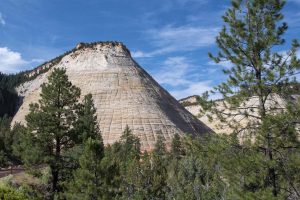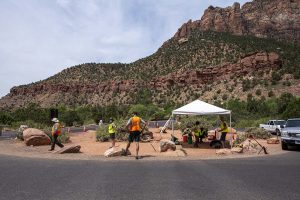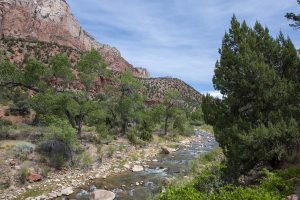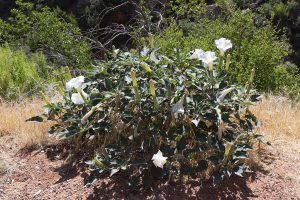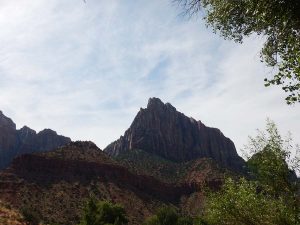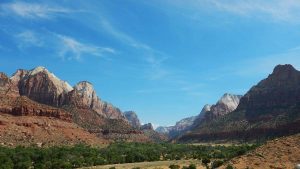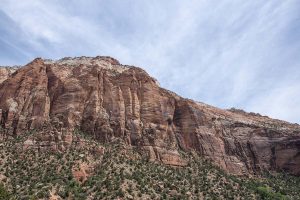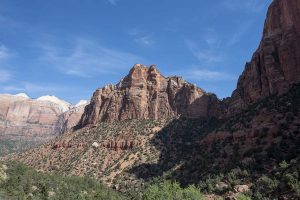Day Seventeen: June 26
I titled the previous post “Bryce Canyon and Zion” because I thought at first I’d cover both yesterday and today in one journal entry. But then I droned on too long and decided on a separate post after all.
I was unsure about my plan today. I’ve arrived in an area where a lot of smallish National Parks are clustered closely together, and I plan to visit as many as I can: I’ll be here for some time, my next two hotel transfers staying within the general area. Zion National Park is off to the west, more distant than the rest of the cluster, and my coming moves will be to the east. So obviously if I want to see it, the time is before my next move.
However, checking online shows that Zion’s sort-of half closed at the moment. They’re not running their park-and-ride shuttle along the park’s scenic drive (Rocky Mountain and Bryce are both running their shuttles with reduced capacity on the buses, but Zion’s just not running theirs at all). The result is that the scenic drive just closes down when all the parking along it is filled, which happens early in the morning due to all-day hikers getting an early start.
It’s an hour drive to Zion from Bryce, do I want to make the commute if the park’s main scenic spots will be unavailable? The other option is to do more hiking here at Bryce.
I decided in the end to go ahead to Zion National Park; and as with Dinosaur Monument and its closed museum, I was not disappointed.
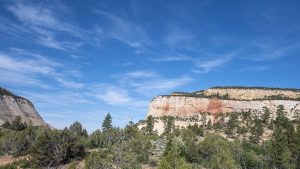
Zion National Park lies a “step down” on the Grand Staircase. Bryce is at the top, its red rocks representing the most recent geological era of this region, a huge freshwater lake that lasted millions of years (from during the age of the dinosaurs until the time the region was uplifted during the formation of the Rockies). Zion’s top level dates from an earlier period, when this area was a sand dune desert like the modern Sahara— but far larger than the Sahara is today. The Ranger who talk I listened to yesterday said it was the largest desert in the history of the planet.
The ancient sand dunes are the top layer of Zion National Park, but its main feature, Zion Canyon, cuts right down through the layers of the Grand Staircase. Here’s some of what I saw driving the main park entry road.
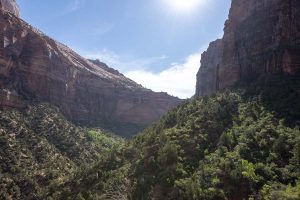 |
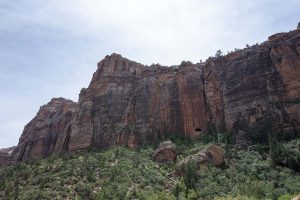 |
A group of Rangers staffed a roadblock where the scenic drive turns off from the main road that runs through the park.
Info displays at the Visitor Center (some distance on from here) explain the reason why Zion established its park-and-ride shuttles: by 1999, 5000 cars a day would try to drive a scenic road with 450 parking spaces in total. With the shuttles closed, and not much reduction in crowds, the scenic drive fills up fast.
Cars were lined up along the side of the road waiting to be let in. The system is, when a certain number of cars has exited, they let a certain number in. I did not wait in the car line, but I parked to take some pictures in the immediate area.
One funny thing happened while I was here: a white van pulled up and the man driving asked the Ranger at the barricade to be let in. “I have to pick up my kids,” he said. “We dropped them off early this morning to hike, and planned to come back to pick them up. They called and they’re waiting at the trailhead.”
The Ranger looked uncomfortable and looked for guidance to a much older Ranger nearby, who shook his head. “Can’t let him in,” the older Ranger said.
“Sorry,” the younger Ranger told the driver. “They’ll have to hike down and meet you here, or you can get in line and wait.”
“Fine,” said the driver grumpily, and drove on.
The older Ranger then said to his younger colleague, “He was lying to you. He’s driven by five times today, with a different story every time.”
Some pictures clearly showing the unique pattern when dry sand dunes compact into sandstone. Instead of the usual flat, parallel layers which may be bent or tilted by later uplift, sand dunes fossilize into layers at all different angles, reflecting the way the dunes changed direction over thousands of years as prevailing winds shifted.
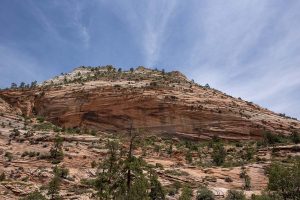 |
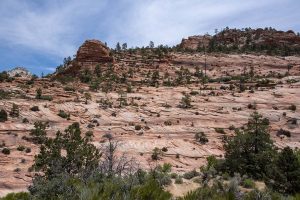 |
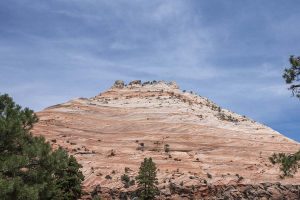 |
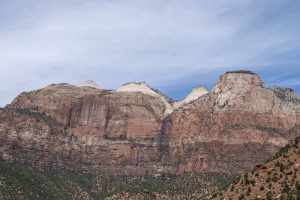 |
With the scenic drive closed, my visit to Zion didn’t take long, and I was back to Bryce Canyon by around three this afternoon. It’s not looking good for another star picture attempt tonight: as I type thunderstorms are rolling through, so it’s a good time to be inside writing these posts.
Tomorrow I shift hotels, moving east to a hotel near Capitol Reef National Park. It’s a short drive so I expect time to look around; it’ll be more than just a drive day.
Trip Report:
Miles driven today: 171.9
Total miles so far: 3485.4

